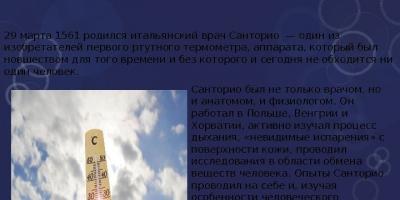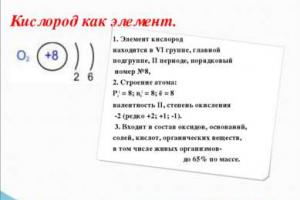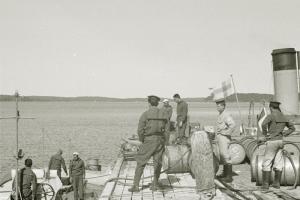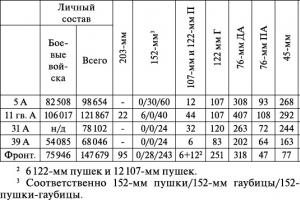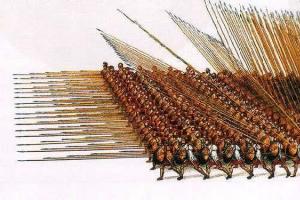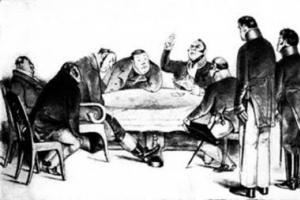For the last 200 years of humanity studied the properties of substances better than in the entire history of the development of chemistry. Naturally, the number of substances is also growing rapidly; this is due, first of all, to the development of various methods for obtaining substances.
In everyday life we come across many substances. Among them are water, iron, aluminum, plastic, soda, salt and many others. Substances that exist in nature, such as oxygen and nitrogen contained in the air, substances dissolved in water and of natural origin, are called natural substances. Aluminum, zinc, acetone, lime, soap, aspirin, polyethylene and many other substances do not exist in nature.
They are obtained in the laboratory and produced by industry. Artificial substances are not found in nature; they are created from natural substances. Some substances that exist in nature can also be obtained in a chemical laboratory.
Thus, when potassium permanganate is heated, oxygen is released, and when chalk is heated, oxygen is released. carbon dioxide. Scientists have learned to turn graphite into diamond; they are growing crystals of ruby, sapphire and malachite. So, along with substances of natural origin, there are a huge number of artificially created substances that are not found in nature.
Substances not found in nature are produced in various enterprises: factories, factories, combines, etc.
In the context of depletion of the natural resources of our planet, chemists now face an important task: to develop and implement methods by which it is possible to artificially, in a laboratory or industrial production, obtain substances that are analogues of natural substances. For example, reserves of fossil fuels in nature are running out.
There may come a time when oil and natural gas run out. Already, new types of fuel are being developed that would be just as efficient, but would not pollute the environment. Today, humanity has learned to artificially obtain various precious stones, for example, diamonds, emeralds, and beryls.
State of matter
Substances can exist in several states of aggregation, three of which are known to you: solid, liquid, gaseous. For example, water in nature exists in all three states of aggregation: solid (in the form of ice and snow), liquid (liquid water) and gaseous (water vapor). There are known substances that cannot exist under normal conditions in all three states of aggregation. For example, such a substance is carbon dioxide. At room temperature it is an odorless and colorless gas. At a temperature of –79°C this substance “freezes” and turns into a solid state of aggregation. The everyday (trivial) name for such a substance is “dry ice”. This name is given to this substance due to the fact that “dry ice” turns into carbon dioxide without melting, that is, without transitioning to a liquid state of aggregation, which is present, for example, in water.
Thus, an important conclusion can be drawn. A substance, when transitioning from one state of aggregation to another, does not transform into other substances. The process of a certain change, transformation, is called a phenomenon.
Physical phenomena. Physical properties of substances.
Phenomena in which substances change their state of aggregation, but do not transform into other substances, are called physical. Each individual substance has certain properties. The properties of substances may be different or similar to each other. Each substance is described using a set of physical and chemical properties. Let's take water as an example. Water freezes and turns into ice at a temperature of 0°C, and boils and turns into steam at a temperature of +100°C. These phenomena are considered physical, since water has not turned into other substances, only a change in the state of aggregation occurs. These freezing and boiling points are physical properties specific to water.
Properties of substances that are determined by measurements or visually in the absence of transformation of some substances into others are called physical
Evaporation of alcohol, like evaporation of water– physical phenomena, substances in this case change their state of aggregation. After the experiment, you can be sure that alcohol evaporates faster than water - these are the physical properties of these substances.
The main physical properties of substances include the following: state of aggregation, color, odor, solubility in water, density, boiling point, melting point, thermal conductivity, electrical conductivity. Physical properties such as color, smell, taste, crystal shape can be determined visually using the senses, and density, electrical conductivity, melting and boiling points are determined by measurement. Information about the physical properties of many substances is collected in specialized literature, for example, in reference books. The physical properties of a substance depend on its state of aggregation. For example, the densities of ice, water and water vapor are different.
Gaseous oxygen is colorless, but liquid oxygen is blue. Knowledge of physical properties helps to “recognize” many substances. For example, copper- The only metal that is red in color. Only table salt has a salty taste. Iodine- An almost black solid that turns into a purple vapor when heated. In most cases, to identify a substance, you need to consider several of its properties. As an example, let us characterize the physical properties of water:
- color – colorless (in small volumes)
- smell - no smell
- state of aggregation - liquid under normal conditions
- density – 1 g/ml,
- boiling point – +100°С
- melting point – 0°С
- thermal conductivity – low
- electrical conductivity - pure water does not conduct electricity
Crystalline and amorphous substances
When describing the physical properties of solids, it is customary to describe the structure of the substance. If you examine a sample of table salt under a magnifying glass, you will notice that the salt consists of many tiny crystals. In salt deposits you can also find very large crystals. Crystals are solids in the shape of regular polyhedra. Crystals can have different shapes and sizes. Crystals of certain substances, such as table salt salt – fragile and easy to break. There are crystals that are quite hard. For example, diamond is considered one of the hardest minerals. If you examine table salt crystals under a microscope, you will notice that they all have a similar structure. If we consider, for example, glass particles, they will all have a different structure - such substances are called amorphous. Amorphous substances include glass, starch, amber, and beeswax. Amorphous substances are substances that do not have a crystalline structure
Chemical phenomena. Chemical reaction.
If during physical phenomena substances, as a rule, only change their state of aggregation, then during chemical phenomena the transformation of some substances into other substances occurs. Here are some simple examples: burning of a match is accompanied by charring of wood and the release of gaseous substances, that is, an irreversible transformation of wood into other substances occurs. Another example: Over time, bronze sculptures become covered with a green coating. The fact is that bronze contains copper. This metal slowly interacts with oxygen, carbon dioxide and air moisture, as a result of which new green substances are formed on the surface of the sculpture Chemical phenomena - phenomena of transformation of one substance into another The process of interaction of substances with the formation of new substances is called a chemical reaction. Chemical reactions occur all around us. Chemical reactions also occur within ourselves. In our body, transformations of many substances continuously occur; substances react with each other, forming reaction products. Thus, in a chemical reaction there are always reacting substances and substances formed as a result of the reaction.
- Chemical reaction– the process of interaction of substances, as a result of which new substances with new properties are formed
- Reagents- substances that enter into a chemical reaction
- Products– substances formed as a result of a chemical reaction
A chemical reaction is represented in general form by a reaction diagram REAGENTS -> PRODUCTS
- reagents– starting materials taken to carry out the reaction;
- products– new substances formed as a result of a reaction.
Any chemical phenomena (reactions) are accompanied by certain signs, with the help of which chemical phenomena can be distinguished from physical ones. Such signs include changes in the color of substances, the release of gas, the formation of sediment, the release of heat, and the emission of light.
Many chemical reactions are accompanied by the release of energy in the form of heat and light. As a rule, such phenomena are accompanied by combustion reactions. In combustion reactions in air, substances react with oxygen contained in the air. For example, the metal magnesium flares up and burns in air with a bright, blinding flame. This is why magnesium flash was used to create photographs in the first half of the 20th century. In some cases, it is possible to release energy in the form of light, but without releasing heat. One type of Pacific plankton is capable of emitting a bright blue light, clearly visible in the dark. The release of energy in the form of light is the result of a chemical reaction that occurs in the organisms of this type of plankton.
Summary of the article:
- There are two large groups of substances: substances of natural and artificial origin.
- Under normal conditions, substances can exist in three states of aggregation
- Properties of substances that are determined by measurements or visually in the absence of transformation of some substances into others are called physical
- Crystals are solids in the shape of regular polyhedra.
- Amorphous substances are substances that do not have a crystalline structure
- Chemical phenomena - phenomena of transformation of one substance into another
- Reagents are substances that enter into a chemical reaction.
- Products are substances formed as a result of a chemical reaction
- Chemical reactions can be accompanied by the release of gas, sediment, heat, light; change in color of substances
- Combustion is a complex physicochemical process of converting starting substances into combustion products during a chemical reaction, accompanied by intense release of heat and light (flame)
Dynamic change is built into nature itself. Everything changes one way or another every moment. If you look carefully, you will find hundreds of examples of physical and chemical phenomena that are completely natural transformations.
Change is the only constant in the Universe
Oddly enough, change is the only constant in our Universe. To understand physical and chemical phenomena (examples in nature are found at every step), it is customary to classify them into types, depending on the nature of the final result caused by them. There are physical, chemical and mixed changes, which contain both the first and the second.
Physical and chemical phenomena: examples and meaning
What is a physical phenomenon? Any changes that occur in a substance without changing its chemical composition are physical. They are characterized by changes in physical attributes and material state (solid, liquid or gas), density, temperature, volume that occur without changing its fundamental chemical structure. There is no creation of new chemical products or changes in the total mass. Additionally, this type of change is usually temporary and in some cases completely reversible.
When you mix chemicals in a laboratory, it is easy to see the reaction, but there are many chemical reactions happening in the world around you every day. A chemical reaction changes molecules, while a physical change only rearranges them. For example, if we take chlorine gas and sodium metal and combine them, we get table salt. The resulting substance is very different from any of its constituent parts. This is a chemical reaction. If we then dissolve this salt in water, we are simply mixing salt molecules with water molecules. There is no change in these particles, it is a physical transformation.
Examples of physical changes
Everything is made of atoms. When atoms combine, different molecules are formed. The different properties that objects inherit are a consequence of different molecular or atomic structures. The basic properties of an object depend on their molecular arrangement. Physical changes occur without changing the molecular or atomic structure of objects. They simply transform the state of an object without changing its nature. Melting, condensation, volume change and evaporation are examples of physical phenomena.
Additional examples of physical changes: metal expanding when heated, sound transmitted through air, water freezing into ice in winter, copper being drawn into wires, clay forming on various objects, ice cream melting into a liquid, metal heating and changing into another form, iodine sublimation when heating, the fall of any object under the influence of gravity, ink being absorbed by chalk, magnetization of iron nails, a snowman melting in the sun, glowing incandescent lamps, magnetic levitation of an object.

How do you differentiate between physical and chemical changes?
Many examples of chemical and physical phenomena can be found in life. It is often difficult to tell the difference between the two, especially when both can occur at the same time. To determine physical changes, ask the following questions:
- Is the state of an object's state a change (gaseous, solid, and liquid)?
- Is the change purely limited to a physical parameter or characteristic such as density, shape, temperature or volume?
- Is the chemical nature of the object a change?
- Do chemical reactions occur that lead to the creation of new products?
If the answer to one of the first two questions is yes, and the answers to subsequent questions are no, it is most likely a physical phenomenon. Conversely, if the answer to any of the last two questions is positive, while the first two are negative, it is certainly a chemical phenomenon. The trick is to simply observe clearly and analyze what you see.

Examples of chemical reactions in everyday life
Chemistry happens in the world around you, not just in the laboratory. Matter interacts to form new products through a process called a chemical reaction or chemical change. Every time you cook or clean, it's chemistry in action. Your body lives and grows through chemical reactions. There are reactions when you take medication, light a match and sigh. Here are 10 chemical reactions in everyday life. This is just a small sampling of the physical and chemical phenomena in life that you see and experience many times every day:
- Photosynthesis. Chlorophyll in plant leaves converts carbon dioxide and water into glucose and oxygen. It is one of the most common daily chemical reactions, and also one of the most important because it is how plants make food for themselves and animals and convert carbon dioxide into oxygen.
- Aerobic cellular respiration is a reaction with oxygen in human cells. Aerobic cellular respiration is the opposite process of photosynthesis. The difference is that energy molecules combine with the oxygen we breathe to release the energy our cells need, as well as carbon dioxide and water. The energy used by cells is chemical energy in the form of ATP.
- Anaerobic respiration. Anaerobic respiration produces wine and other fermented foods. Your muscle cells perform anaerobic respiration when you deplete the oxygen supply, such as during intense or prolonged exercise. Anaerobic respiration by yeasts and bacteria is used for fermentation to produce ethanol, carbon dioxide and other chemicals that produce cheese, wine, beer, yogurt, bread and many other common foods.
- Combustion is a type of chemical reaction. This is a chemical reaction in everyday life. Every time you light a match or a candle, or start a fire, you see a combustion reaction. Combustion combines energy molecules with oxygen to produce carbon dioxide and water.
- Rust is a common chemical reaction. Over time, iron develops a red, flaky coating called rust. This is an example of an oxidation reaction. Other everyday examples include the formation of verdigris on copper and tarnishing of silver.
- Mixing chemicals causes chemical reactions. Baking powder and baking soda perform similar functions in baking, but they react differently to other ingredients, so you can't always substitute another. If you combine vinegar and baking soda for a chemical "volcano" or milk and baking powder in a recipe, you are experiencing a double displacement or metathesis reaction (plus a few others). The ingredients are recombined to produce carbon dioxide gas and water. Carbon dioxide creates bubbles and helps the baked goods "grow". These reactions appear simple in practice, but often involve several steps.
- Batteries are examples of electrochemistry. Batteries use electrochemical or redox reactions to convert chemical energy into electrical energy.
- Digestion. Thousands of chemical reactions occur during digestion. As soon as you put food in your mouth, an enzyme in your saliva called amylase begins to break down sugars and other carbohydrates into simpler forms that your body can absorb. The hydrochloric acid in your stomach reacts with food to break it down, and enzymes break down proteins and fats so they can be absorbed into the blood through the intestinal wall.
- Acid-base reactions. Whenever you mix an acid (e.g. vinegar, lemon juice, sulfuric acid, hydrochloric acid) with an alkali (e.g. baking soda, soap, ammonia, acetone), you are performing an acid-base reaction. These processes neutralize each other, producing salt and water. Sodium chloride is not the only salt that can be formed. For example, here is the chemical equation for the acid-base reaction that produces potassium chloride, a common table salt substitute: HCl + KOH → KCl + H2O.
- Soap and detergents. They are purified through chemical reactions. Soap emulsifies dirt, which means oil stains bind to the soap so they can be removed with water. Detergents reduce the surface tension of water so they can interact with oils, sequestering them and washing them away.
- Chemical reactions during cooking. Cooking is one big hands-on chemistry experiment. Cooking uses heat to cause chemical changes in food. For example, when you boil an egg hard, hydrogen sulfide produced by heating the egg white can react with the iron from the egg yolk, forming a gray-green ring around the yolk. When you cook meat or baked goods, the Maillard reaction between amino acids and sugars produces the brown color and desired flavor.

Other examples of chemical and physical phenomena
Physical properties describe characteristics that do not change a substance. For example, you can change the color of the paper, but it's still paper. You can boil water, but when you collect and condense the steam, it is still water. You can determine the mass of a piece of paper, and it is still paper.
Chemical properties are those that show how a substance reacts or does not react with other substances. When sodium metal is placed in water, it reacts violently to form sodium hydroxide and hydrogen. Enough heat is generated as the hydrogen escapes into the flame, reacting with the oxygen in the air. On the other hand, when you put a piece of copper metal in water, no reaction occurs. So the chemical property of sodium is that it reacts with water, but the chemical property of copper is that it does not.
What other examples of chemical and physical phenomena can be given? Chemical reactions always occur between electrons in the valence shells of atoms of elements in the periodic table. Physical phenomena at low energy levels simply involve mechanical interactions—random collisions of atoms without chemical reactions, such as atoms or gas molecules. When collision energies are very high, the integrity of the nucleus of atoms is disrupted, leading to fission or fusion of the species involved. Spontaneous radioactive decay is generally considered a physical phenomenon.
>> Physical and chemical phenomena (chemical reactions). Let's experiment at home. External effects in chemical reactions
Physical and chemical phenomena (chemical reactions)
The material in this paragraph will help you figure out:
>what is the difference between physical and chemical phenomena.(chemical reactions);
> what external effects accompany chemical reactions.
In natural history lessons, you learned that various physical and chemical phenomena occur in nature.
Physical phenomena.
Each of you has repeatedly observed how ice melts, water boils or freezes. Ice, water and water vapor consist of the same molecules, so they are one substance (in different states of aggregation).
Phenomena in which a substance does not transform into another are called physical.
Physical phenomena include not only changes in substances, but also the glow of hot bodies, the passage of electric current in metals, the spread of the smell of substances in the air, the dissolution of fat in gasoline, and the attraction of iron to a magnet. Such phenomena are studied by the science of physics.
Chemical phenomena (chemical reactions).
One of the chemical phenomena is combustion. Let's consider the process of burning alcohol (Fig. 46). It occurs with the participation of oxygen contained in the air. When burned, alcohol seemingly turns into a gaseous state, just as water turns into steam when heated. But that's not true. If the gas obtained as a result of the combustion of alcohol is cooled, then part of it will condense into liquid, but not into alcohol, but into water. The rest of the gas will remain. With the help of additional experiment it can be proven that this residue is carbon dioxide.
Rice. 46. Burning alcohol
So the alcohol that burns and oxygen, which participates in the combustion process, are converted into water and carbon dioxide.
Phenomena in which some substances are transformed into others are called chemical phenomena or chemical reactions.
Substances that enter into a chemical reaction are called starting substances, or reagents, and those that are formed are called final substances, or reaction products.
The essence of the chemical reaction considered is conveyed by the following entry:
alcohol + oxygen -> water + carbon dioxide
starting materials final substances
(reagents) (reaction products)
The reactants and products of this reaction are made up of molecules. During combustion, a high temperature is created. Under these conditions, the molecules of the reagents disintegrate into atoms, which, when combined, form molecules of new substances - products. Therefore, all atoms are conserved during the reaction.
If the reactants are two ionic substances, then they exchange their ions. Other variants of interaction of substances are also known.
External effects accompanying chemical reactions.
By observing chemical reactions, the following effects can be recorded:
Change in color (Fig. 47, a);
gas release (Fig. 47, b);
formation or disappearance of sediment (Fig. 47, c);
appearance, disappearance or change in odor;
release or absorption of heat;
the appearance of a flame (Fig. 46), sometimes a glow.

Rice. 47. Some external effects during chemical reactions: a - appearance
coloring; b - gas release; c - appearance of sediment
Laboratory experiment No. 3
The appearance of color as a result of the reaction
Are solutions of soda ash and phenolphthalein colored?
Add 2 drops of phenolphthalein solution to a portion of soda solution I-2. What color appeared?
Laboratory experiment No. 4
Release of gas as a result of the reaction
Add a little chloride acid to the soda ash solution. What are you observing?
Laboratory experiment No. 5
The appearance of a precipitate as a result of the reaction
Add 1 ml of copper sulfate solution to the soda ash solution. What's happening?
The appearance of a flame is a sign of a chemical reaction, i.e. it indicates a chemical phenomenon. Other external effects can also be observed during physical phenomena. Let's give a few examples.
Example 1. Silver powder obtained in a test tube as a result of a chemical reaction is gray in color. If you melt it and then cool the melt, you will get a piece of metal, but not gray, but white, with a characteristic shine.
Example 2. If you heat natural water, gas bubbles will begin to emerge from it long before boiling. This is dissolved air; its solubility in water decreases when heated.
Example 3. An unpleasant odor in the refrigerator disappears if granules of silica gel, one of the silicon compounds, are placed in it. Silica gel absorbs molecules of various substances without destroying them. Activated carbon works in a similar way in a gas mask.
Example 4 . When water turns into steam, heat is absorbed, and when water freezes, heat is released.
To determine what kind of transformation has occurred - physical or chemical, you should carefully observe it, as well as comprehensively examine the substances before and after the experiment.
Chemical reactions in nature, everyday life and their significance.
Chemical reactions occur constantly in nature. Substances dissolved in rivers, seas, and oceans interact with each other, some react with oxygen. Plants absorb carbon dioxide from the atmosphere, water and dissolved substances from the soil and process them into proteins, fats, glucose, starch, vitamins, other compounds, as well as oxygen.
This is interesting
As a result of photosynthesis, about 300 billion tons of carbon dioxide are absorbed from the atmosphere each year, 200 billion tons of oxygen are released, and 150 billion tons of organic substances are formed.
Reactions involving oxygen, which enters living organisms during respiration, are very important.
Many chemical reactions accompany us in everyday life. They occur during frying meat, vegetables, baking bread, souring milk, fermenting grape juice, bleaching fabrics, burning various types of fuel, hardening cement and alabaster, blackening silver jewelry over time, etc.
Chemical reactions form the basis of such technological processes as the extraction of metals from ores, the production of fertilizers, plastics, synthetic fibers, medicines, and other important substances. By burning fuel, people provide themselves with heat and electricity. Using chemical reactions, they neutralize toxic substances and process industrial and household waste.
The occurrence of some reactions leads to negative consequences. Rusting of iron shortens the life of various mechanisms, equipment, vehicles, and leads to large losses of this metal. Fires destroy housing, industrial and cultural facilities, and historical values. Most foods spoil due to their interaction with oxygen in the air; in this case, substances are formed that have an unpleasant odor, taste and are harmful to humans.
conclusions
Physical phenomena are the phenomena in which each substance is conserved.
Chemical phenomena, or chemical reactions, are the transformation of one substance into another. They can be accompanied by various external effects.
Many chemical reactions occur in the environment, in plants, animals and humans, and accompany us in everyday life.
?
100. Match:
1) dynamite explosion; a) physical phenomenon;
2) solidification of molten paraffin; b) chemical phenomenon.
3) food burning in a frying pan;
4) the formation of salt during the evaporation of sea water;
5) separation of a strongly shaken mixture of water and vegetable oil;
6) fading of dyed fabric in the sun;
7) passage of electric current in the metal;
101. What external effects are accompanied by such chemical transformations: a) burning of a match; b) rust formation; c) fermentation of grape juice.
102. Why do you think some food products (sugar, starch, vinegar, salt) can be stored indefinitely, while others (cheese, butter, milk) quickly spoil?
Experimenting at home
External effects in chemical reactions
1. Prepare small amounts of aqueous solutions of citric acid and baking soda. Pour portions of both solutions together into a separate glass. What's happening?
Add a few soda crystals to the remainder of the citric acid solution, and a few citric acid crystals to the remainder of the soda solution. What effects do you observe - the same or different?
2. Pour some water into three small glasses and add 1-2 drops of brilliant green alcohol solution, known as “zelenka,” to each. Add a few drops of ammonia to the first glass, and citric acid solution to the second. Has the color of the dye (green) in these glasses changed? If so, how exactly?
Write down the results of the experiments in a notebook and draw conclusions.
Popel P. P., Kryklya L. S., Chemistry: Pidruch. for 7th grade zagalnosvit. navch. closing - K.: VC "Academy", 2008. - 136 p.: ill.
Lesson content lesson notes and supporting frame lesson presentation interactive technologies accelerator teaching methods Practice tests, testing online tasks and exercises homework workshops and trainings questions for class discussions Illustrations video and audio materials photographs, pictures, graphs, tables, diagrams, comics, parables, sayings, crosswords, anecdotes, jokes, quotes Add-ons abstracts cheat sheets tips for the curious articles (MAN) literature basic and additional dictionary of terms Improving textbooks and lessons correcting errors in the textbook, replacing outdated knowledge with new ones Only for teachers calendar plans training programs methodological recommendationsKey words of the abstract: Physical phenomena, chemical phenomena, chemical reactions, signs of chemical reactions, the meaning of physical and chemical phenomena.
Physical phenomena- these are phenomena in which usually only the state of aggregation of substances changes. Examples of physical phenomena are the melting of glass and the evaporation or freezing of water.
Chemical phenomena- these are phenomena as a result of which other substances are formed from given substances. In chemical phenomena, starting substances are transformed into other substances that have different properties. Examples of chemical phenomena are the combustion of fuel, the rotting of organic matter, the rusting of iron, and the souring of milk.
Chemical phenomena are also called chemical reactions.
Conditions for the occurrence of chemical reactions
The fact that during chemical reactions some substances are converted into others can be judged by external signs: release of heat (sometimes light), change in color, appearance of odor, formation of sediment, release of gas.
For many chemical reactions to begin, it is necessary to bring them into close contact of reacting substances . To do this, they are crushed and mixed; The contact area of the reacting substances increases. The finest crushing of substances occurs when they dissolve, so many reactions are carried out in solutions.
Grinding and mixing substances is only one of the conditions for the occurrence of a chemical reaction. For example. When sawdust comes into contact with air at normal temperatures, the sawdust does not ignite. In order for a chemical reaction to begin, in many cases it is necessary to heat substances to a certain temperature.

It is necessary to distinguish between concepts "conditions of occurrence" And “conditions for the flow of chemical reactions” . So, for example, in order for combustion to begin, heating is only necessary at the beginning, and then the reaction proceeds with the release of heat and light, and further heating is not required. And in the case of water decomposition, an influx of electrical energy is necessary not only to start the reaction, but also for its further course.
The most important conditions for the occurrence of chemical reactions are:
- thorough grinding and mixing of substances;
- preheating substances to a certain temperature.
The meaning of physical and chemical phenomena
Chemical reactions are of great importance. They are used to produce metals, plastics, mineral fertilizers, medicines, etc., and also serve as a source of various types of energy. Thus, when fuel burns, heat is released, which is used in everyday life and in industry.
All vital processes (respiration, digestion, photosynthesis, etc.) occurring in living organisms are also associated with various chemical transformations. For example, chemical transformations of substances contained in food (proteins, fats, carbohydrates) occur with the release of energy, which is used by the body to support vital processes.
Lesson summary “Physical and chemical phenomena (chemical reactions).”
1. Close contact of the reacting substances (necessary): H 2 SO 4 + Zn = ZnSO 4 + H 2 2. Heating (possible) a) to start the reaction b) constantly Classification of chemical reactions according to various criteria 1. Based on the presence of a phase boundary, all chemical reactions are divided into homogeneous And heterogeneous A chemical reaction occurring within one phase is called homogeneous chemical reaction. The chemical reaction occurring at the interface is called heterogeneous chemical reaction. In a multi-step chemical reaction, some steps may be homogeneous while others may be heterogeneous. Such reactions are called homogeneous-heterogeneous. Depending on the number of phases that form the starting materials and reaction products, chemical processes can be homophasic (starting substances and products are within one phase) and heterophasic (starting substances and products form several phases). Homo- and heterophasicity of a reaction is not related to whether the reaction is homo- or heterogeneous. Therefore, four types of processes can be distinguished: Homogeneous reactions (homophasic). In this type of reaction, the reaction mixture is homogeneous and the reactants and products belong to the same phase. An example of such reactions is ion exchange reactions, for example, neutralization of an acid solution with an alkali solution: Heterogeneous homophasic reactions. The components are within one phase, but the reaction occurs at the phase boundary, for example, on the surface of the catalyst. An example would be the hydrogenation of ethylene over a nickel catalyst: Homogeneous heterophasic reactions. The reactants and products in such a reaction exist within several phases, but the reaction occurs in a single phase. This is how the oxidation of hydrocarbons in the liquid phase with gaseous oxygen can take place. Heterogeneous heterophasic reactions. In this case, the reactants are in different phase states, and the reaction products can also be in any phase state. The reaction process occurs at the phase boundary. An example is the reaction of carbonic acid salts (carbonates) with Bronsted acids: 2. By changing the oxidation states of the reactants[edit | edit wiki text] In this case, a distinction is made between redox reactions, in which atoms of one element (oxidizing agent) are being restored , that is, they lower their oxidation state, and the atoms of another element (reducing agent) oxidize , that is, they increase their oxidation state. A special case of redox reactions are proportionation reactions, in which the oxidizing and reducing agents are atoms of the same element in different oxidation states. An example of a redox reaction is the combustion of hydrogen (a reducing agent) in oxygen (an oxidizing agent) to form water: An example of a comporportionation reaction is the decomposition reaction of ammonium nitrate when heated. In this case, the oxidizing agent is nitrogen (+5) of the nitro group, and the reducing agent is nitrogen (-3) of the ammonium cation: They do not belong to redox reactions in which there is no change in the oxidation states of atoms, for example: 3. According to the thermal effect of the reaction All chemical reactions are accompanied by the release or absorption of energy. When chemical bonds in reagents are broken, energy is released, which is mainly used to form new chemical bonds. In some reactions the energies of these processes are close, and in this case the overall thermal effect of the reaction approaches zero. In other cases, we can distinguish: exothermic reactions that occur with the release of heat (positive thermal effect) CH 4 + 2O 2 = CO 2 + 2H 2 O + energy (light, heat); CaO + H 2 O = Ca (OH) 2 + energy (heat). endothermic reactions during which heat is absorbed (negative thermal effect) from the environment. Ca(OH) 2 + energy (heat) = CaO + H 2 O The thermal effect of a reaction (enthalpy of reaction, Δ r H), which is often very important, can be calculated using Hess’s law if the enthalpies of formation of the reactants and products are known. When the sum of the enthalpies of the products is less than the sum of the enthalpies of the reactants (Δ r H< 0) наблюдается выделение тепла, в противном случае (Δ r H >0) - absorption. 4. By type of transformation of reacting particles[edit | edit wiki text] compounds: decomposition: substitution: exchange (including the type of reaction - neutralization): Chemical reactions are always accompanied by physical effects: absorption or release of energy, change in the color of the reaction mixture, etc. It is by these physical effects that people are often judged about the occurrence of chemical reactions. Compound reaction- a chemical reaction as a result of which only one new substance is formed from two or more starting substances. Both simple and complex substances can enter into such reactions. Decomposition reaction-a chemical reaction that results in the formation of several new substances from one substance. Reactions of this type involve only complex compounds, and their products can be both complex and simple substances Substitution reaction- a chemical reaction as a result of which the atoms of one element that are part of a simple substance replace the atoms of another element in its complex compound. As follows from the definition, in such reactions one of the starting substances must be simple and the other complex. Exchange reactions- a reaction as a result of which two complex substances exchange their constituent parts 5. Based on the direction of occurrence, chemical reactions are divided into irreversible and reversible Chemical reactions that proceed in only one direction are called irreversible. from left to right"), as a result of which the starting substances are transformed into reaction products. Such chemical processes are said to proceed “to the end.” These include combustion reactions, and reactions accompanied by the formation of poorly soluble or gaseous substances Reversible are chemical reactions that occur simultaneously in two opposite directions (“from left to right” and “from right to left”). In the equations of such reactions, the equal sign is replaced by two oppositely directed arrows. Among two simultaneously occurring reactions, they are distinguished straight( flows from left to right) and reverse(proceeds “from right to left”). Since during a reversible reaction the starting substances are simultaneously consumed and formed, they are not completely converted into reaction products. Therefore, reversible reactions are said to proceed “not completely.” As a result, a mixture of starting substances and reaction products is always formed. 6. Based on the participation of catalysts, chemical reactions are divided into catalytic And non-catalytic Catalytic 2SO 2 + O 2 → 2SO 3 (catalyst V 2 O 5) are reactions that occur in the presence of catalysts. In the equations of such reactions, the chemical formula of the catalyst is indicated above the equal sign or reversibility sign, sometimes along with the designation of the conditions of occurrence. Reactions of this type include many decomposition and combination reactions. Non-catalytic 2NO+O2=2NO 2 refers to many reactions that occur in the absence of catalysts. These are, for example, exchange and substitution reactions.
